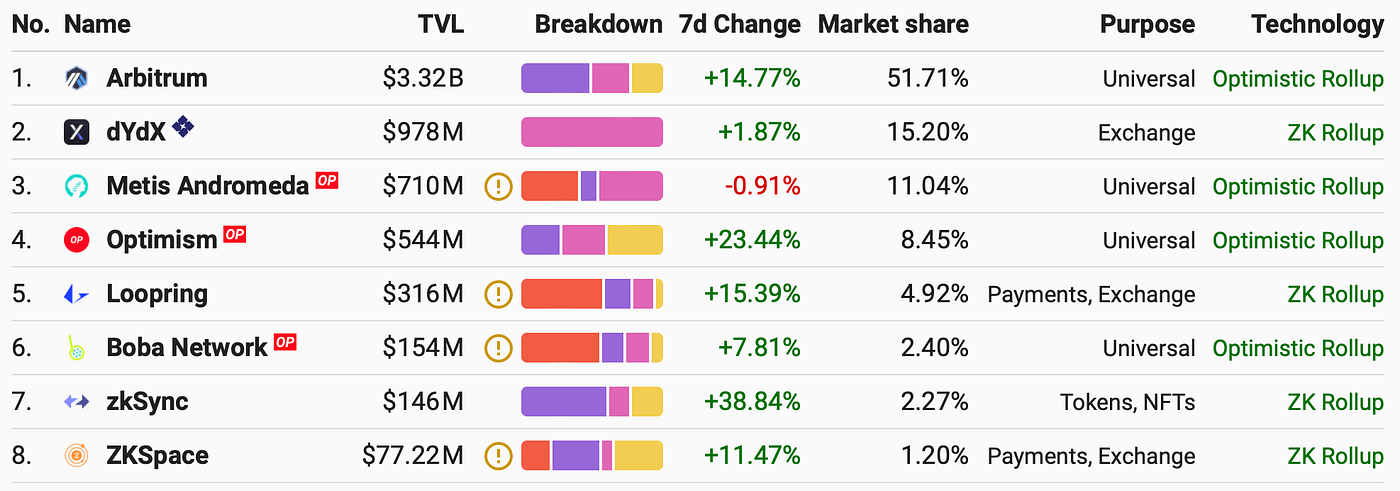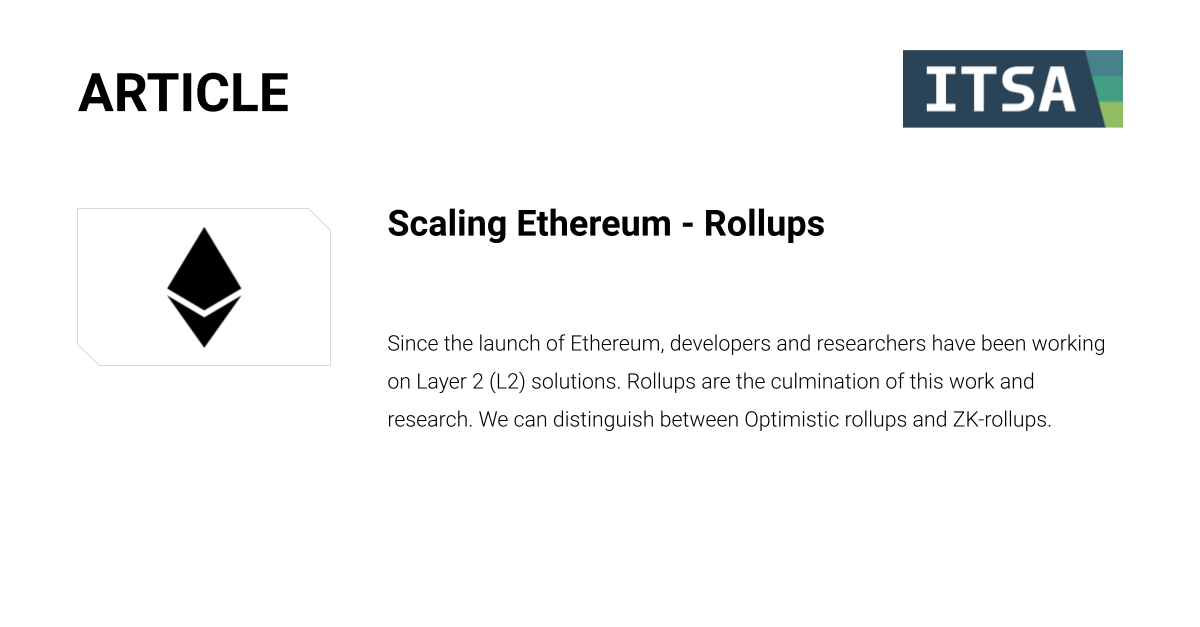ITSA Article
Listing Ethereum Rollups in Tokenbase
Listing Ethereum Rollups in Tokenbase
Since the launch of Ethereum, developers and researchers have been working on Layer 2 (L2) solutions. Rollups are the culmination of this work and research. Historically L2s started with the Lighting network on Bitcoin. The general idea of L2s is instead of putting all activity on the blockchain, users perform the bulk of their activity off-chain while relying on the security of the main chain. We can distinguish between Optimistic rollups and ZK-rollups.
Authors: Valentin Kalinov, Christian Viehof
History
The first L2 solution in the blockchain space is the Bitcoin Lightning Network (LN), first introduced in 2018. It allows users to transact with each other at almost zero costs. Scaling Ethereum is more challenging because of the complexity of the technology and the Ethereum Virtual Machine (EVM), which allows for the execution of code known as smart contracts. We have seen countless proposals on how to scale Ethereum so it could accommodate the influx of applications running on top of it. The initial idea of L2s goes back to Plasma, and later Rollups were adopted as the solution for scaling Ethereum. Plasma was co-authored with Joseph Poon and Vitalik Buterin, which started the journey of the ultimate scaling solution for Ethereum. In 2018 ZK-proofs and fraud proofs were introduced as concepts for L2 solutions. In 2020 the design evolved into rollups.
What is Layer 2?
When we talk about Ethereum and Bitcoin, we call these Layer one (L1) blockchains. These L1s are protected by a consensus protocol such as Proof-of-Work (PoW) and Proof-of-Stake (PoS). L2 are vertically scaled blockchains on top of L1 blockchains that allow lower fees with the same trust model of the L1 blockchain. The L2s are completely trustless in their design. They allow for dramatic scale without the need to develop new trust solutions. Sidechains are such examples where entities need to develop additional trust mechanisms. The general idea of L2 is that users could trust it as much as they trust Ethereum or any L1 blockchain.
What are rollups?
We can distinguish between Optimistic rollups and ZK rollups. By moving the computation on L2, a rollup needs a way to prove to Ethereum what happened on L2. In a sense, Ethereum guarantees for L2 even though the computation was not done by the Ethereum network. Optimistic rollups post the data to Ethereum by assuming it is correct. There are no additional steps required, which also keeps the fees low. Each time a rollup needs to send a transaction to Ethereum, it would need to pay the Ethereum network fee. In case of invalid transactions, optimistic rollups have introduced a dispute mechanism where malicious parties are penalized for submitting wrong transactions to Ethereum. The tool for challenging is called fraud proofs. If someone wants to submit fraud proof they would also need to place a bond as insurance that they are not spamming the network or not submitting spam transactions. If fraud proof turns out to be wrong, the bond gets slashed.
ZK rollups, unlike optimistic rollups, don’t require fraud proofs. Instead, every batch of data posted to layer 1 includes a cryptographic proof called a ZK-SNARK:
“A zk-SNARK allows you to generate a proof that some computation has some particular output, in such a way that the proof can be verified extremely quickly even if the underlying computation takes a very long time to run.”, Vitalik Buterin
Unlike optimistic rollups, ZK rollups provide instant proof to Ethereum that the computation on L2 is correct. Anyone can assure you that they operated with integrity without you needing to trust them or re-execute or inspect what they did. Due to the requirement of posting a cryptographic proof with each transaction, ZK rollups have naturally higher network fees than optimistic rollups.
Which rollup technology will establish itself as leading is yet to be seen. Both have their advantages and disadvantages and will help L1s scale in the near future. Moving to Proof-of-Stake would also help Ethereum reduce network fees. The concept of sharding is also expected to help Ethereum scale.
Rollup overview
As we are moving into an L1 multi-chain future, we also expect to have multi-chain L2s. Arbitrum and Optimism are currently the most popular optimistic rollups on the market. Both projects have different approaches to treating smart contract code. Without going too deep into detail, Arbitrum uses its own Arbitrum Virtual Machine (AVM) while Optimism uses Ethereum-like EVM. As of today, we can see that the market has spoken for Arbitrum. Since rollups rely on L1, they don’t need a token to stay secure and to incentivize miners. Some projects, however, have decided to introduce a token to their rollup. Such example of an optimistic rollup is Metis. The native token of the Metis ecosystem is METIS.

As we can see from the chart above, optimistic rollups are currently winning against ZK rollups in terms of Total Value Locked (TVL). The top ZK rollups are zkSync, Loopring and dYdX. ZKSync is a Universal purpose rollup without a token. DYdx is a ZK rollup specially designed as a decentralized exchange with its own token called dYdX. Loopring has also focused on becoming an exchange with its own token called LRC. The rollup space continues to evolve, and we expect to see many things change in the near future.
The classification of Loopring (LRC) according to the ITC:

Economic Purpose (EEP): LRC is listed as a settlement and access token (EEP22TU02).
Industry Type (EIN): The issuer of LRC is active in the field of decentralized exchanges, markets, and market-making (EIN06DF01).
Technological Setup (TTS): LRC is an Ethereum ERC-20 Standard Token (TTS42ET01). The Class “Ethereum ERC-20 Standard Token” captures every token that is implemented by means of the ERC-20 Standard.
Legal Clam (LLC): The LRC token does not entitle its holder to any legal claim or rights against the issuing organization therefore it is listed as a No-Claim Token (LLC31).
Issuer Type (LIT): The dimension “Issuer Type” provides information on the nature of the issuer of the token. The Loopring infrastructure is built by Loopring Technology Limited which is a Private Sector Legal Entity (LIT61PV).
Regulatory Framework (EU) (REU): The dimension “Regulatory Status EU” provides information on the potential classification of a token according to the European Commission’s proposal for a Regulation on Markets in Crypto Assets (MiCA, Regulation Proposal COM/2020/593 final). The LRC token qualifies as a Utility Token; Crypto Asset in the Scope of MiCA (REU51UT) according to the definition provided in Article 3 (5) of Regulation Proposal COM/2020/593 final.
List of rollup tokens:

The International Token Standardization Association (ITSA) e.V.
The International Token Standardization Association (ITSA) e.V. is a not-for-profit association of German law that aims at promoting the development and implementation of comprehensive market standards for the identification, classification, and analysis of DLT- and blockchain-based cryptographic tokens. As an independent industry membership body, ITSA unites over 100 international associated founding members from various interest groups. In order to increase transparency and safety on global token markets, ITSA currently develops and implements the International Token Identification Number (ITIN) as a market standard for the identification of cryptographic tokens, the International Token Classification (ITC) as a standard framework for the classification of cryptographic tokens according to their inherent characteristics. ITSA then adds the identified and classified token to the world’s largest register for tokens in our Tokenbase.
- The International Token Identification Number (ITIN) is a 9-digit alphanumeric technical identifier for both fungible and non-fungible DLT-based tokens. Thanks to its underlying Uniform Token Locator (UTL), ITIN presents a unique and fork-resilient identification of tokens. The ITIN also allows for the connecting and matching of other media and data to the token, such as legal contracts or price data, and increases safety and operational transparency when handling these tokens.
- The International Token Classification (ITC) is a multi-dimensional, expandable framework for the classification of tokens. Current dimensions include technological, economic, legal, and regulatory dimensions with multiple sub-dimensions. By mid-2021, there will be at least two new dimensions added, including a tax dimension. So far, our classification framework has been applied to 99% of the token market according to the market capitalization of classified tokens.
- ITSA’s Tokenbase currently holds data on over 4000 tokens. Tokenbase is a holistic database for the analysis of tokens and combines our identification and classification data with market and blockchain data from external providers. Third-party data of several partners is already integrated, and API access is also in development.
Remarks
This article was originally published by Kalinoff (source: blog.kalinoff.com).
If you like this article, we would be happy if you forward it to your colleagues or share it on social networks. More information about the International Token Standardization Association can be found on the Internet, on Twitter, or on LinkedIn.
Valentin Kalinov is an Executive Director at International Token Standardization Association (ITSA) e.V., working to create the world’s largest token database, including a classification framework and unique token identifiers and locators. He has over five years of experience working at BlockchainHub Berlin in content creation and token analysis, as a project manager at the Research Institute for Cryptoeconomics at the Vienna University of Economics and token analyst at Token Kitchen. You can contact Valentin via valentin.kalinov@itsa.global and connect on Linkedin if you would like to further discuss ITSA e.V. or have any other open questions.
Christian Viehof is an Executive Director at the International Token Standardization Association (ITSA) e.V., working to create the world’s largest token database including a classification framework and unique token identifiers and locators. He completed his Bachelor in Economics at the University of Bonn, the Hong Kong University and the London School of Economics and Political Science with a focus on Behavioral Economics and Finance. Currently pursuing his Master of Finance at the Frankfurt School of Finance and Management, you can contact him via christian.viehof@itsa.global and connect with him on Linkedin, if you would like to further discuss ITSA e.V. or have any open questions.

